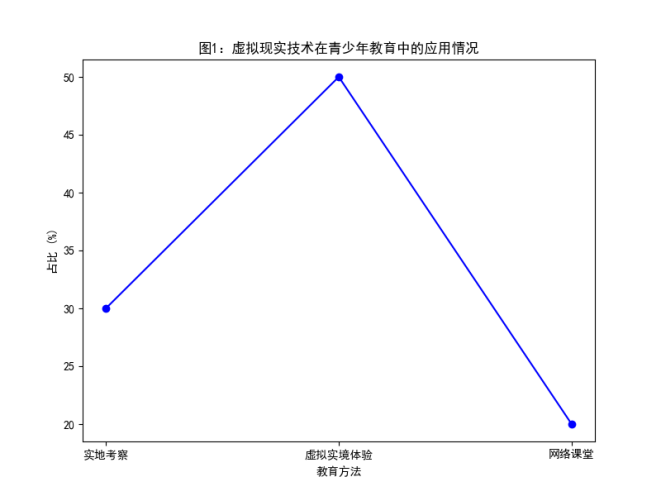
Abstract:
This study discusses the application of virtual reality technology in youth education, and analyzes it from an interdisciplinary perspective. Through literature review and case study, we found that virtual reality technology has broad application prospects in youth education and can improve students's interest in learning and participation. At the same time, this study discussed the role of virtual reality technology in interdisciplinary education, and found that it can promote the integration and interaction between different disciplines, so as to improve students' interdisciplinary thinking ability. This study analyzes the challenges and opportunities of VR technology in youth education, and presents some coping strategies and suggestions to provide a reference for future research and practice.
Keywords: virtual reality technology, youth education, learning experience, teaching effect, innovative thinking, personalized teaching, learning interest, educational reform
1. Introduce
1.1 Research Background
|
application area |
functional description |
superiority |
|
mathematics education |
Virtual demonstration, practical operation |
Improve the interest in learning, enhance the memory |
|
science education |
Simulation experiments, 3 D presentation |
Deepen understanding and cultivate practical ability |
|
History education |
Virtual reproduction of historical scenes |
Vivid and intuitive, enhance immersion |
Table 1: Application of virtual reality technology in youth education
In the field of modern education, virtual reality technology, as a new means of education, has gradually attracted the attention of youth educators and researchers. This technology can not only provide students with a more vivid and intuitive learning experience, but also stimulate their interest in learning and initiative. Virtual reality technology can also effectively improve the learning efficiency, and help teenagers to better understand and master the content of knowledge. Therefore, through exploring the application of virtual reality technology in adolescent education interdisciplinary, this paper aims to explore the effectiveness and feasibility of this technology in teaching practice, and to provide reference and inspire [1] for adolescent educators.
1.2 Significance of the Study
The purpose of this study is to explore the application of virtual reality technology in adolescent education and to explore the possible positive effects of [2]. As an innovative teaching tool, virtual reality technology can provide a new learning experience, stimulate students' interest and enthusiasm in learning, and promote them to understand and master knowledge more deeply.
Youth education is the cornerstone of social development, and youth are the future of the country. The quality and level of their education are directly related to the development and competitiveness of the country. The application of virtual reality technology can not only enrich the teaching means, improve the teaching effect, but also cultivate the students' innovative thinking and practical ability, and improve their comprehensive quality. Therefore, it is of important theoretical and practical significance to study the application of virtual reality technology in adolescent education, which is expected to bring new changes and develop [3] in the field of adolescent education.
2. Application of virtual reality technology in youth education
2.1 Overview of virtual reality technology
In the paper, the section "Overview of virtual reality technology" describes the basic definition, characteristics and applications of VR technology in detail. Virtual reality technology is a technology that uses a computer-generated simulation environment and allows users to experience and interact personally. With virtual reality technology, users can immerse themselves in a fictional environment and interact with the objects or scenes in them in real time.
In mathematics, we can use the following formulas to represent the 3 D reconstruction process in virtual reality technology:
2.2 The current situation of youth education
Youth education is faced with many problems and challenges, including the decline of interest in learning, increased learning pressure, and single teaching methods. Teenagers are the future of the country, and the quality of their education is directly related to the development and future competitiveness of the country. Therefore, we urgently need to reform and innovate the ways and methods of youth education, so that it is more in line with the characteristics and needs of teenagers, and to cultivate their innovative thinking and comprehensive ability.
The importance of adolescent education can not be ignored, we must pay attention to the comprehensiveness and individuation of education, and provide more diversified and flexible education mode for teenagers. Only in this way can we ensure that teenagers have better performance and development space in the future competition. The application of virtual reality technology brings new possibilities for youth education, which can better stimulate their interest in learning and improve their learning effect. Therefore, it is necessary to explore the application of virtual reality technology in adolescent education [4].
2.3 The potential of virtual reality technology in youth education
Virtual reality technology can provide an immersive learning experience, allowing students to deeply understand the knowledge through various sensory ways such as audio-visual. For example, when learning history, students can travel through time and space through virtual reality technology, and feel the charm of history and culture more intuitively. Virtual reality technology can also stimulate students' interest and hands-on ability through interactive learning methods, making the learning process more vivid and interesting. Youth education should give full play to the advantages of virtual reality technology, break the shackles of traditional teaching, and create a more innovative and effective learning environment. The application of virtual reality technology will bring broader potential and possibilities for youth education [5].
3. Interdisciplinary exploration of VR technology
3.1 The perspective of pedagogy
The application of virtual reality technology in education has brought a brand new learning experience to teenagers. It can stimulate students' interest and enhance their engagement and focus. Through the virtual laboratory, virtual scenes and other ways, students can practice and experience it personally, and deepen their understanding and memory of knowledge. This immersive learning method effectively stimulates students' motivation to learn and makes learning more vivid and interesting.
Virtual reality technology can also help teachers to guide students 'learning, adjust and customize the teaching content according to students' actual situation. Through big data analysis of students 'performance in the virtual environment, teachers can better grasp students' learning needs, timely provide teaching feedback and provide personalized guidance, so as to improve teaching quality and efficiency.
In general, virtual reality technology has injected new vitality into youth education, and promoted the innovation of teaching mode and the improvement of teaching effect. In the future, with the continuous development and improvement of virtual reality technology, it will play a more important role in the field of education and open up broader possibilities for teenagers to learn.
3.2 Psychological perspective

Figure 1: Application of virtual reality technology in youth education
From the psychological perspective, the application of virtual reality technology in adolescent education presents many effects [6]. Through the simulation of the virtual reality environment, teenagers can experience the learning content more intuitively, and improve the attractiveness and interest of learning. Virtual reality technology can simulate real situations while providing more personalized learning experience, helping teenagers to better develop their personal strengths and interests. Virtual reality technology can also promote the emotional development of teenagers and enhance their self-confidence and social skills. Therefore, combined with the psychological perspective, the application of virtual reality technology in adolescent education has great significance and potential.
3.3 computer science
The application of virtual reality technology in computer science has become a hot topic. With the continuous development of technology, virtual reality technology has been widely used in game development, simulation training, healthcare and other fields. From the perspective of computer science, virtual reality technology is closely connected with human-computer interaction, graphics, data processing and other fields, presenting a huge space for innovation.
One of the development trends of virtual reality technology is to combine with cutting-edge technologies such as artificial intelligence and big data to achieve a more intelligent and personalized experience. For example, through deep learning algorithms, virtual reality systems can better understand users' behaviors and needs, and achieve more accurate interaction and feedback. Virtual reality technology also has a wide range of application prospects in computer science. For example, in the field of education, combining artificial intelligence technology to realize personalized and interactive learning experience, and improve students' interest in learning and effect [7].
4. Study methods and design
4.1 Recruitment of participants
The key part of the study methodology and design is the participant recruitment. We took a variety of ways to recruit participants, including posting recruitment information in schools, communities, and online platforms to ensure the diversity and representativeness of the sample. The criteria for participants included age between 13 and 18 years, some experience with VR technology use, and interest in education and learning. We also paid special attention to factors such as gender, race, and educational background to ensure the diversity and scientificity of the sample. Through well-designed recruitment strategies, we successfully attracted a group of eligible participants, providing a reliable data base for the study. During the course of the study, we will further analyze the participants' feedback and performance to explore the potential application and impact of VR technology on in adolescent education[8].
4.2 Data collection method
To ensure the reliability and validity of the data, multiple data collection methods were used in this study. We designed a questionnaire for adolescents, including questions about the cognition and attitudes of VR technology in education. Through this questionnaire, we can obtain adolescent views of the practical application and potential value of virtual reality technology.
In addition to the questionnaire, we made field observations and participated in some of virtual reality techniques in the actual curriculum in education. By observing the students' learning behavior and interaction in the virtual reality environment, we can have a deeper understanding of their acceptance of the virtual reality technology and their learning effect.
We also used face-to-face interviews to conduct in-depth communication with a number of adolescents and educators to explore their views and suggestions on the use of VR in education. Through the combination of multiple data collection methods, we can comprehensively and accurately evaluate the practical effects and development prospects of VR technology in youth education.
5. Study dings and discussion
5.1 Presentation of the results
The results show that education using VR can significantly increase adolescents' interest and participation in learning. In the experiment, the students showed higher concentration and learning enthusiasm in the virtual reality environment. Compared with traditional teaching, virtual reality technology has achieved better results in knowledge transfer and understanding. Students showed greater memory and comprehension while completing virtual experiments and simulated scenes.
Statistics show that most students show their love and support for virtual reality education. They believe that this new learning method can increase the fun of learning and improve the learning effect. Students also experience more learning freedom and diversity when using virtual reality technology.
Overall, VR technology has great potential in youth education, and can provide new exploration and development opportunities for multidisciplinary interdisciplinary teaching [9].
5.2 Results analysis
By studying the application of virtual reality technology in youth education, we find that this technology can stimulate students' interest and enthusiasm in learning, and improve their participation and investment. At the same time, virtual reality technology can also help students to obtain a more intuitive and in-depth experience in practice, and deepen their understanding and memory of knowledge.
In the teaching process of using virtual reality technology, we also found some problems and trends. For example, some students may be confused or unadapted due to their unfamiliarity with the new technology and will need more guidance and support. The application of VR technology in education also requires more teacher training and teaching resources to support [10].
Through the analysis of these questions and trends, we can provide more reference for further discussion and conclusions. The application of virtual reality technology in youth education can not only expand the traditional teaching mode, but also provide students with more learning opportunities and experiences, which is expected to become one of the important trends in the future development of education.
6. Conclusion and Outlook
The application of virtual reality technology in adolescent education has great significance and potential. This new means of education not only provides a more vivid and intuitive learning experience, but also stimulates students' interest and initiative in learning, and improves their learning efficiency. The interdisciplinary exploration of virtual reality technology has brought new changes and development to youth education, and provided a new learning style and environment. Through virtual reality technology, students can practice and experience for themselves, and deeply understand and master the knowledge. At the same time, virtual reality technology can also guide students to learn in personalized, providing a more diversified and flexible education model. The application of virtual reality technology brings a new learning experience to teenagers, and improves the learning effect and participation. However, there are still some problems and challenges in youth education, such as students' adaptation to new technologies and the training of teachers. Therefore, continued in-depth research and exploration of VR applications are needed to better meet the needs and challenges of adolescent education. Through continuous innovation and improvement, virtual reality technology is expected to become one of the important trends in future education, opening up a broader possibilities for teenagers to learn.
Funding
This research received no external funding.
Author Contributions
All authors have read and agreed to the published version of the manuscript.
The authors declared that they have no known competing financial interests or personal relationships that could have appeared to influence the work reported in this paper.
References
